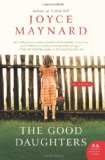Summary | Excerpt | Reading Guide | Reviews | Beyond the Book | Readalikes | Genres & Themes | Author Bio

A Novel
by Joyce Maynard
Sitting in the backseat—the way-back, actually, this being the days before
seat belt regulations—I felt a small, hopeful surge of promise, like a faint, thin
shaft of light coming through the door, or the hint of breeze on a sweltering day.
I loved to draw, a fact my mother hadn’t seemed to notice.
My mother said nothing. Why would she want to pursue any activity that
linked me closer to Val Dickerson? Even as my mother sought the woman out,
she seemed so filled with judgment and reproach.
“There’s a Howard Johnson’s up ahead, girls,” she said. “We’ll get you each
a cone. Just not chocolate. It stains.”
Afterward, standing in the parking lot, licking my ice cream—the one person
in our family who chose coffee, when everybody else favored strawberry or
vanilla—I thought about a picture I’d seen on the wall at the Dickersons.
It was a print by an artist who was popular at the time, an image of a thin
girl with straggly hair and big eyes that filled up half her face. She was holding a
flower. The feeling it gave you, looking at this picture, was that the girl the artist
had painted was the only person in the world (and very likely this was the only
flower). Nobody could be more alone than that girl. And the funny thing was
that though I lived in a big family—with my four sisters, crammed into three
bedrooms—this was how I felt, too, growing up in that house.
Not that she ever did anything so different, but I had a sense that in some
odd way I could not understand, but registered in my heart, my mother never
took to me as she did to my sisters. I would feel it when I saw her with one of
the others—Naomi, whose hair she liked to braid, or Esther, for whom she had
found the nickname “Tootsie,” or Sarah, known as “Honeybun.”
“What’s my nickname?”I asked her one time. She had looked at me with a
blank expression then, as if the thought of coming up with yet another endearment
was beyond her capacity.
“Ruth,” she said. “That’s a fine name.”
This was when my father stepped in. “I think I’ll call you Beanpole,” he
said.
I was different from my sisters. Different from my mother most of all. They
didn’t know this about me, but I made up odd stories, and sometimes, as I did,
I drew pictures of the things I dreamed up, and sometimes these pictures were
so strange, and possibly even shocking, I hid them in my sock drawer. Though
there was one person I showed them to, when I had a chance. Ray Dickerson.
The second time we visited them in Vermont, I brought Ray a picture of the
two of us—Ray and me—on a spaceship, both of us in spacesuits but still clearly
recognizable, with an image of Saturn out the window. At school we’d just done
a unit on astronauts and they’d told us about Ham, the chimpanzee they sent
into space—an idea that had haunted me, because my teacher never mentioned
any plans for bringing the chimp home, only launching him—meaning he was
destined to orbit the earth forever, I guessed, until the food ran out and all that
was left was a chimp skeleton. In my picture, I was half girl, half chimpanzee.
Ray looked like a chimpanzee too.
“Sometimes, I feel like that chimp they launched into space,” he said, when
I showed him my picture.
“Only it wouldn’t be so lonely if you had company,” I said, thinking of how
in the picture there had been two of us.
He just looked at me then. Maybe he was thinking, What am I doing talking
to a little kid? He looked like he might say something—an expression he often
had, actually—but he didn’t speak. He just grabbed his unicycle and took off
down the driveway, though not before stuffing my picture in his jeans pocket.
This was another thing about Ray: he disappeared abruptly. One minute you
were having the best conversation. Then he was gone.
Excerpted from The Good Daughters by Joyce Maynard. Copyright © 2010 by Joyce Maynard. Excerpted by permission of William Morrow. All rights reserved. No part of this excerpt may be reproduced or reprinted without permission in writing from the publisher.
Your guide toexceptional books
BookBrowse seeks out and recommends the best in contemporary fiction and nonfiction—books that not only engage and entertain but also deepen our understanding of ourselves and the world around us.